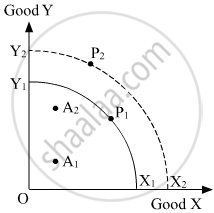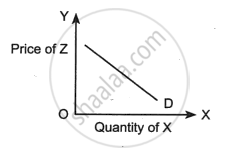Advertisements
Advertisements
प्रश्न
Give reason or explain the following statement.
Demand curve slopes downward from left to right.
उत्तर
Demand curve is the graphical representation of the relationship between the demand for a good and its price, for a given income, price of related goods, tastes and preferences. This curve slopes downwards from left to right because of the negative relationship between price of the commodity and its demand.

APPEARS IN
संबंधित प्रश्न
Demand for necessaries is................
(elastic / inelastic / infinitely elastic / unitary elastic)
Define demand. Name the factors affecting market demand.
Distinguish between ‘increase in demand’ and increase in quantity demanded of a good.
When is demand called perfectly inelastic?
Demand for electricity is elastic.
Give one reason for shift in demand curve.
State with reason. Whether you ‘agree’ or ‘disagree’ with the following statement:
There are no exceptions to the law of Demand.
Fill in the blank with proper alternatives given in the bracket:
Indirect demand is also known as _______ demand.
Answer the following question.
State and explain the law of demand.
Write whether the following statement is True or False:
Demand curve has a positive slope.
(b) less elastic demand
(c) zero elastic demand
(d) unitary elastic demand
Define or explain the concept of Demand schedule.
Distinguish between :
Individual demand schedule and Market demand schedule.
fill in the blank with appropriate alternatives given in the bracket:
Demand for salt is ___________.
Write answers in ‘one’ or ‘two’ paras each.
What are the main determinants of aggregate demand?
Fill in the blank with appropriate alternatives given below:
Indirect demand is also known as _____________ demand.
Match the following:
|
Group A
|
Group B
|
|
1. Demand and price
|
a. Substitute goods
|
|
2. Tea and coffee
|
b. Inverse relation
|
|
3. Inferior goods
|
c. Joint demand
|
|
4. Factors of production
|
d. Distribution of income
|
|
5. Pen and ink
|
e. Composite demand
|
|
|
f. Giffen goods
|
|
|
g. Indirect demand
|
State whether the following statement is TRUE and FALSE
Desire means demand.
State whether the following statement is TRUE and FALSE
When demand increases, the demand curve shifts to the left.
State whether the following statement is TRUE and FALSE
Quantity demanded varies directly with price.
State whether the following statement is TRUE and FALSE
Law of demand is explained by Prof. Robbins.
Give reason or explain the following statement.
Demand for factors of production is derived demand.
Fill in the blank using appropriate alternatives given below
The demand for perishable goods is _______
Answer the following question.
Discuss the relationship between the income of the consumer and demand for a commodity with respect to normal goods, inferior goods, and necessities.
If the income of a consumer increases, discuss briefly its likely impact on the demand for a inferior good, Good X.
Choose the correct answer from given options
In the given figure X1Y1 and X2Y2 are Production Possibility Curves in two different periods T1 and T2 respectively for Good X and Good Y. A1 and A2 represent actual outputs and P1 and P2 represent potential outputs respectively in the two times periods.

The change in actual output of Goods X and Y over the two periods would be represented by a movement from __________.
In case of ______ supply curve is a vertical straight line parallel to Y-axis.
If the price of good X rises and it leads to an increase in demand for good Y, both are ______ goods.
Which of the following points relates to the transaction demand for money?
There is a sudden change in climatic conditions resulting in hot weather. Assuming no change in the price of the cold drinks, it will lead to ______
Which of the following points are related to the 'Paradox of Thrift'?
Are the concepts of demand for domestic goods and domestic demand for goods the same?
Identify the correct pair of items from the following Columns I and II:
| Column I | Column II |
| (1) Budget Line | (a) Normal goods |
| (2) Bajra | (b) Inferior goods |
| (3) Consumer equilibrium | (c) Luxurious goods |
| (4) Elastic Demand | (d) M = Px*x + py*y |
Area under MC curve is equal to:
Which of the following statements is true?
Which of the following have elastic demand?
Aggregate demand can be decreased by:
Which of the following statements is correct with respect to the correction of Excess Demand?
Which of the following statements is false?
Which of the following statements is true?
"Market demand curve is constructed by horizontally summing all the individual's demand curves at each and every price." Choose the correct option for the above-mentioned statement.
Read the case study and answer the questions 97 to 100:
The Coca-Cola Company is an American multinational beverage company, with its headquarters in Atlanta, Georgia. The first company that conducted its operation in the soft drink industry was Coca-Cola. It is the world's largest non-alcoholic beverage company serving more than 1.8 billion consumers daily in more than 200 countries. It has a portfolio of more than 3,500 (more than 800 no or low-calorie) products. However, the company is best known for its flagship product Coca-Cola which was originally intended to be a patented medicine invented in 1886 by pharmacist John Smith Pemberton in Columbus, Georgia. The Coca-Cola products can be termed as normal goods and in August 2019 Coca-Cola introduced a new product into the market, that is, zero sugar where the demand has increased for the product in the market.
According to the council of the Australian Food Technology Association and Institute of Food Science and Technology, the Australian nonalcoholic beverages industry has been growing steadily, with a 2.3 percent increase in overall production in the year 2000 which amounts to 2.25 billion liters. However, in the re~ent years, sales of customary carbonated soft drinks have dropped as more and more customers become health conscious and move away from high-calorie sugary drinks. Soft Carbonated drinks. and other alcohol-free beverage manufacturers have also sensed the effects of intensifying competition from private-label soft drink makers. Nevertheless, sales of greater value energy and sports drinks have driven profit generation in the industry.
______ is the want to buy a product backed by purchasing power.
Read the case study and answer the questions 97 to 100:
The Coca-Cola Company is an American multinational beverage company, with its headquarters in Atlanta, Georgia. The first company that conducted its operation in the soft drink industry was Coca-Cola. It is the world's largest non-alcoholic beverage company serving more than 1.8 billion consumers daily in more than 200 countries. It has a portfolio of more than 3,500 (more than 800 no or low-calorie) products. However, the company is best known for its flagship product Coca-Cola which was originally intended to be a patented medicine invented in 1886 by pharmacist John Smith Pemberton in Columbus, Georgia. The Coca-Cola products can be termed as normal goods and in August 2019 Coca-Cola introduced a new product into the market, that is, zero sugar where the demand has increased for the product in the market.
According to the council of the Australian Food Technology Association and Institute of Food Science and Technology, the Australian nonalcoholic beverages industry has been growing steadily, with a 2.3 percent increase in overall production in the year 2000 which amounts to 2.25 billion liters. However, in the re~ent years, sales of customary carbonated soft drinks have dropped as more and more customers become health conscious and move away from high-calorie sugary drinks. Soft Carbonated drinks. and other alcohol-free beverage manufacturers have also sensed the effects of intensifying competition from private-label soft drink makers. Nevertheless, sales of greater value energy and sports drinks have driven profit generation in the industry.
What has happened to the demand of zero sugar carbonated drinks?
Demand deposits include:
Which of the following statements is true?
Assertion (A): Demand deposits are not legal tenders.
Reason (R): They are with the bank, so only can be used as a legal tender when cheques are issued for the transfer.
The figure given below shows the relation between the quantity demanded for the good X and the price of the good Z. What type of goods are X and Z?

Read the passage given below and answer the questions that follow.
|
In India, Fixed deposits have long been a favourite investment choice of people, especially senior citizens, as it promise steady returns. It attracts those who are seeking a stable income. But it’s an illusion in the period of inflation. Inflation is the rate at which the general level of prices for goods and services rises, subsequently eroding the purchasing power of money. In simple terms, what money could buy today might not a few years down the line. Fixed deposits are financial instruments offered by banks where you deposit a lump sum amount for a fixed period at a predetermined rate of interest. Consider an investment of Rs 1 crore in a fixed deposit at a 6% annual interest rate and the annual rate of inflation is 5%. By the 10th year your pre inflation return is 1.79 crore, but post inflation it’s just 1.10 crore. The nominal value of investment in fixed deposits may appear to grow, inflation significantly diminishes their real value and purchasing power over time.
|
- What is the theme of the extract? (2)
- Differentiate between Demand pull and Cost push inflation. (2)
- What are the demand deposits and time deposits? (2)
- Since 1998 RBI has been using new measures of money supply, M0, M1, M2 and M3. Which one of these measures incorporates fixed deposit as one of its components? Mention the other components of that measure. (2)

